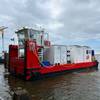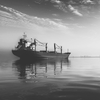The Administration’s proposal to slash the Great Lakes dredging budget by 32 percent in FY12 has the Great Lakes shipping industry declaring a State of Emergency. The Administration’s proposed appropriation for Lakes dredging next year will remove the smallest amount of sediment since the U.S. Army Corps of Engineers started keeping records more than half a century ago. As a result, only 11 of the 83 U.S ports on the Great Lakes will be dredged.
“Never in my 51 years in this industry have I seen such a total abandonment of the Federal government’s responsibility to maintain the Great Lakes Navigation System,” said John D. Baker, President of Great Lakes Maritime Task Force, the largest labor/management coalition ever to promote shipping on America’s Fourth Sea Coast. “Cargo movement on the Fourth Sea Coast can top 200 million tons per year, yet the Federal government is turning its back on us. What was a dredging crisis is now a State of Emergency for each of the eight Great Lakes states. At this funding level, the Corps won’t be able to dredge even half of the sediment that builds up each year. If this proposed dredging budget is implemented, ports will close and cargo will either shift to modes of transportation that burn more fuel and produce more emissions than vessels or production will be moved to other regions of the country or even overseas.”
Baker, who is also President Emeritus of the ILA’s Great Lakes District Council, noted the Great Lakes are shouldering a disproportionate share of the nationwide decrease in Federal dredging funds. “The Lakes budget is being slashed by 32 percent, more than any other navigation system. Why? The Great Lakes basin is America’s industrial heartland, and these waters are our link to overseas markets via the St. Lawrence Seaway, but we are being treated like second-class citizens.”
Approximately 3.5 million cubic yards of sediment build up in Great Lakes ports and waterways each year. Funding for dredging has been inadequate for years, so 15.5 million cubic yards of sediment already clog the system and consequently thousands of tons of cargo are left behind each time a vessel leaves port. The Administration’s budget will only dredge 1.6 million cubic yards next year, so the backlog will balloon to more than 17 million cubic yards unless Congress provides more funds.
Dredging is absolutely essential to efficient shipping on the Lakes and any waterway. “Great Lakes shipyards have built the world’s largest fleet of self-unloading vessels to serve Great Lakes basin industries,” said Eugene (Gene) Caldwell, 1st Vice President of GLMTF. “One full load of iron ore in the largest lakers – 70,000 tons – can keep a steel mill and its thousands of employees working for nearly 5 days. But as it is, the lack of dredging has been trimming 5,000 tons or more off loads. I shudder to think what will happen in 2012.”
Caldwell, who is also Vice President and General Manager of Bay Shipbuilding Company, noted there is no reserve carrying capacity available to serve Lakes industries. “When the economy is strong, the entire fleet is in service. There will be no way to overcome this crippling lack of dredging next year.”
Adding insult to injury is the fact the government can fully fund dredging on the Lakes and nationwide without raising taxes or borrowing. “The Harbor Maintenance Trust Fund (“HMTF”), which is the depository for tax dollars levied on waterborne commerce, has a surplus of $5.65 billion,” said Don Cree, 2nd Vice President of GLMTF. “We all recognize the need for the Federal government to balance the budget, but there is no reason to further reduce spending dredging dollars which were to be held in trust. The HMTF has a surplus precisely because it already doesn’t spend what it should on dredging.”
Cree, who is also Great Lakes Special Assistant to the National President for American Maritime Officers, stressed the need to fully fund dredging is why bills have been introduced in both the House and Senate that would require the HMTF to spend what it takes in each year, about $1.6 billion. “H.R. 104 has 50 cosponsors and S. 412 has 14. We urge those Great Lakes legislators who have yet to cosponsor these bills to do so as quickly as possible and avert an economic catastrophe. Adequate funding, in this case a $200 million appropriation, or 3.5 percent of the HMTF surplus, restores the Great Lakes Navigation System to project dimensions.”
Restoring adequate funding for dredging will also protect the precious Great Lakes environment. “Waterborne commerce is the ‘greenest’ form of transportation,” said James H.I. Weakley, 3rd Vice President of GLMTF and President of Lake Carriers’ Association. “A vessel moves a ton of cargo 600 miles per gallon of fuel. A train goes about 200 miles and truck less than 60. In the process the vessel produces 90 percent less carbon dioxide than the truck and 70 percent less than the locomotive.”










